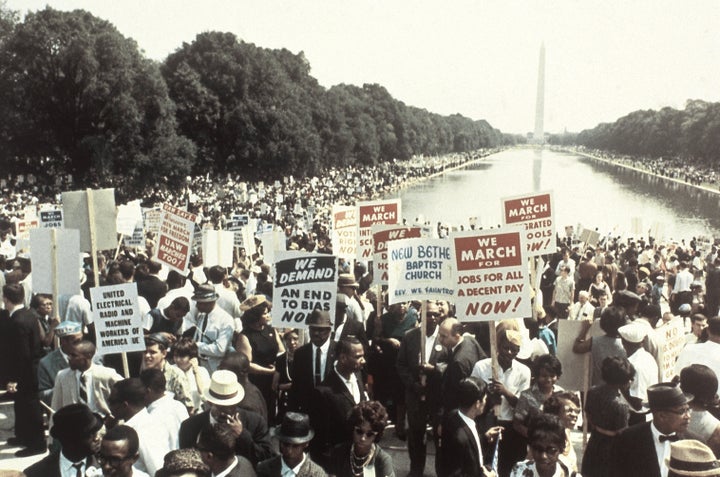
February is Black History Month -- a chance to remember, honor, and celebrate the myriad of gifts that African Americans have given to America and the world. Here at City Year, we recognize that America's greatest strength is its remarkable diversity, and we are proud to add our voice to the national conversation highlighting the invaluable contributions Black Americans have made to the American experience.
Often, this month is used to revisit the words and deeds of heroic leaders like Dr. Martin Luther King, Jr., Frederick Douglas, Rosa Parks, or Thurgood Marshall. It is always valuable to learn from these towering figures of history, but it is important to remember that social change has never come about solely through the isolated efforts of a small handful of great men and women. Rather, the causes of justice and equality have always been advanced through the collective efforts of vast numbers of civic leaders working together for change. An overly narrow focus on heroic individuals may lead to a distorted understanding of history -- and a dismissal of the very real power we each possess to bring about change in the world.
It's a point that is powerfully made in an excellent new book called Everyone Leads, by Paul Schmitz, CEO of Public Allies. He argues that the civil rights movement in America -- like so many other social movements across the globe -- is really a story of collective effort by large numbers of empowered citizens. For example, soon after Rosa Parks was arrested for refusing to give up her seat at the front of a segregated bus in Montgomery, Ala., Dr. King was brought to the community to lead a bus boycott. He played an important role, but make no mistake about it: That bus boycott was only successful because the entire Black population of Montgomery refused to ride a bus -- a tremendous sacrifice and inconvenience! -- for more than a year. Segregated bussing came to end because the entire Black community led -- not just Ms. Parks and Dr. King.
Here's another example: When we think about the famous 1963 March On Washington, the first thing that comes to mind for most of us is Dr. King's prophetic, iconic "I Have a Dream" speech. It important to remember, however, that a key reason why that speech has become so iconic is because it was delivered in front of a vast crowd of 200,000 individuals, all of whom earned the title of "civic leader" through the efforts they made to take a personal stand for jobs and freedom.
As Schmitz makes clear, the story of how that crowd was rallied provides an important glimpse into the reality of social change. The march was organized by A. Phillip Randolph, President of the Brotherhood of Sleeping Car porters -- the first predominantly Black union. Once the decision was made to hold the rally, the organizers had just seven weeks to plan the program and turn out a crowd. Randolph knew exactly who to turn to: Bayard Rustin. It's safe to say that Rustin does not have same level of name recognition today as MLK, but be was absolutely essential to the success of the march. He was Black, gay, socialist -- and the most universally respected community organizer among African Americans of that era. The goal was 100,000 attendees, and in just seven weeks Rustin succeeded at turning out twice that number -- with only the telephone, telegraph, and snail mail as his communication tools!
So the next time you summon that image of Dr. King speaking from the steps of the Lincoln Memorial, make sure you "zoom out" to focus not just on the brilliant orator at the podium, but also on the vast ocean of citizens gathered on the national mall. Remember that it required a Bayard Rustin to gather that crowd, as well as 200,000 civic leaders who personally embraced a commitment to standing for jobs and freedom. From this wide-angle perspective, it's clear that it took far more than a speech by Dr. King to put the "Great" in the "Great March on Washington".
In addition, remember that the Dream shared with the nation on that day has not yet been realized. In most American cities, more than 50 percent of students of color do not graduate from high school. Compared with high school graduates, these young people are three times more likely to be unemployed, and eight times more likely to go to jail. On average, they earn $1 million less over their lifetime than college graduates. This is a tragedy of wasted lives and unrealized potential on a massive scale, and Secretary of Education Arne Duncan has rightly called it "the civil rights issue of our time".
City Year is proud to stand shoulder-to-shoulder with a vast network of educators, organizations, philanthropists, and policy makers who are deeply committed to transforming America's high school graduation rates. We recognize that today -- as in the past -- real change can only be brought about by vast numbers of civic leaders working together to achieve a shared purpose.
As we look back on Black history this month, let us remember that it is the choices we make today that will create the history we will reflect back on tomorrow. Will this generation rise to the challenge of confronting the greatest civil rights issue of our own day? We think it will, and we are committed to working with all those who seek to advance the Dream in our own era. Together, we aspire to write a new chapter in the ongoing struggle for justice, equality, and opportunity that our children will be able to look back on with pride.
